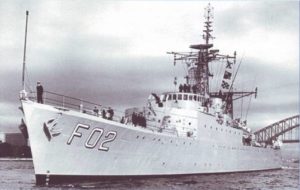- Author
- van Gelder, Commander John RAN (Rtd)
- Subjects
- Biographies and personal histories
- Tags
-
- RAN Ships
- HMAS Quickmatch, HMAS Queenborough
- Publication
- September 2005 edition of the Naval Historical Review (all rights reserved)
It is now comparatively rare for a naval aviator to also qualify as a seagoing watchkeeping officer, but in previous generations it was relatively straightforward and kept one in the mainstream for possible later promotion and eventual sea command.

It was towards the end of 1960. After a little more than twelve months flying Fairey Gannets from HMAS Melbourne I received an Appointment to join the Type 15 Frigate, HMAS Queenborough, to qualify as a seaman officer. In those days officers were “Appointed” to ships and establishments, they were not “Posted.” Furthermore, they were directed to “repair to their duty.” This was a very civilized and olde worlde way of conducting business. Of course, the underlying message was that if one did not “repair to one’s duty” on the “Appointed” date one was likely to be keel-hauled at the first opportunity, or suffer such other punishment as may be considered necessary.
It should be understood that at that time the proportion of commissioned aviators to non-flying officers was relatively high compared to the present situation in the RAN. The majority of Fleet Air Arm Pilots and Observers were granted a six year Short Service Commission on graduation from flying training. During the six year period some officers were offered a permanent commission. The Naval Board in their wisdom probably thought that there could be some value to the RAN in a small proportion of this unsightly and generally non-conformist gaggle of aviators. On award of a permanent commission, one entered the main stream of the Executive Branch and, of necessity, had to obtain a Bridge Watchkeeping Certificate to become a qualified seaman officer, in order to compete in the promotion process. It became an interesting prospect to regard one’s flying experience as simply a specialization in the overall scheme of things.
Thus it was on a beautiful spring morning in October 1960, I found myself going to sea for the first time as an officer in a frigate. Passing through Sydney Heads into an almost flat calm sea with a gentle breeze, I thought life was pretty good. From what little I could ascertain we were engaged in Officer of the Watch Manoeuvres with a sister ship, HMAS Quickmatch and a submarine (whose name I can’t recall). What I do recall is that there were a number of people on the bridge, all busy doing something, except me! The bridge of a Type 15 frigate is very spacious but I found there was virtually no place to hide. All I could do was keep as far away from the compass platform as I could manage and keep silent. After all, I was enjoying this unique experience and was quite convinced that I would not be required to contribute to the activity on the bridge because I knew absolutely nothing about what was going on.
My reverie was abruptly shattered by our very senior and experienced captain who invited me, in no uncertain terms, to join the cluster of individuals gathered around the Pelorus, and for the next manoeuvre I was to act as Officer of the Watch. This, of course, presented me with an immediate and serious problem since I had no idea about what was happening. Obviously I needed assistance from some person with far more experience in these matters than myself. The answer became obvious. Standing nearby was the Navigator. If I could elicit information from him without my total ignorance becoming too public this seemed to be a reasonable solution to the problem.
From that point on the conversations and actions taken on the bridge were roughly as follows:
Over the radio from Quickmatch, who was acting as the Guide came:
“Execute to follow – Formation One – standard distance – my course 090 – speed 14 knots … At the time Quickmatch was about 30 degrees off our starboard bow at about two miles distant. The following dialogue ensued between the Navigator and myself:
Me: “Excuse me, what does Formation One mean?”
Navigator: “It means that we must finish up directly astern of Quickmatch”
Me: “Thank you.”
(I think to myself this is a simple relative velocity problem. Easy, just like joining a formation in an aircraft, an activity at which I was well experienced).
Me: “Oh, another thing, what does Standard Distance mean?”
Navigator: “It means two and a half cables or five hundred yards.”
(I think to myself, thank goodness he explained the matter of cables and yards, because I did not know the length of a cable – well not exactly). Next thing I hear over the radio is “Stand by Execute…” I knew it was bound to happen and had been desperately wondering what I should do when it did happen. I had no choice. A voice of authority behind me said “… Come on, get on with it …” Here was my big chance. Not being a complete idiot and having heard other people use a similar expression I said “… Starboard 20, Revolutions 200…” The ship was turning and accelerating and I waited until steadying on a course which looked to be about right to bring us astern of Quickmatch at the required distance. Turning and lining up into Quickmatch’s wake did not seem to be much of a problem, but we were doing nearly 20 knots and she was doing only 14. Here again the matter was simple. As in joining a formation in the air, reduce engine power when you judge the time is right and slide neatly into position.




